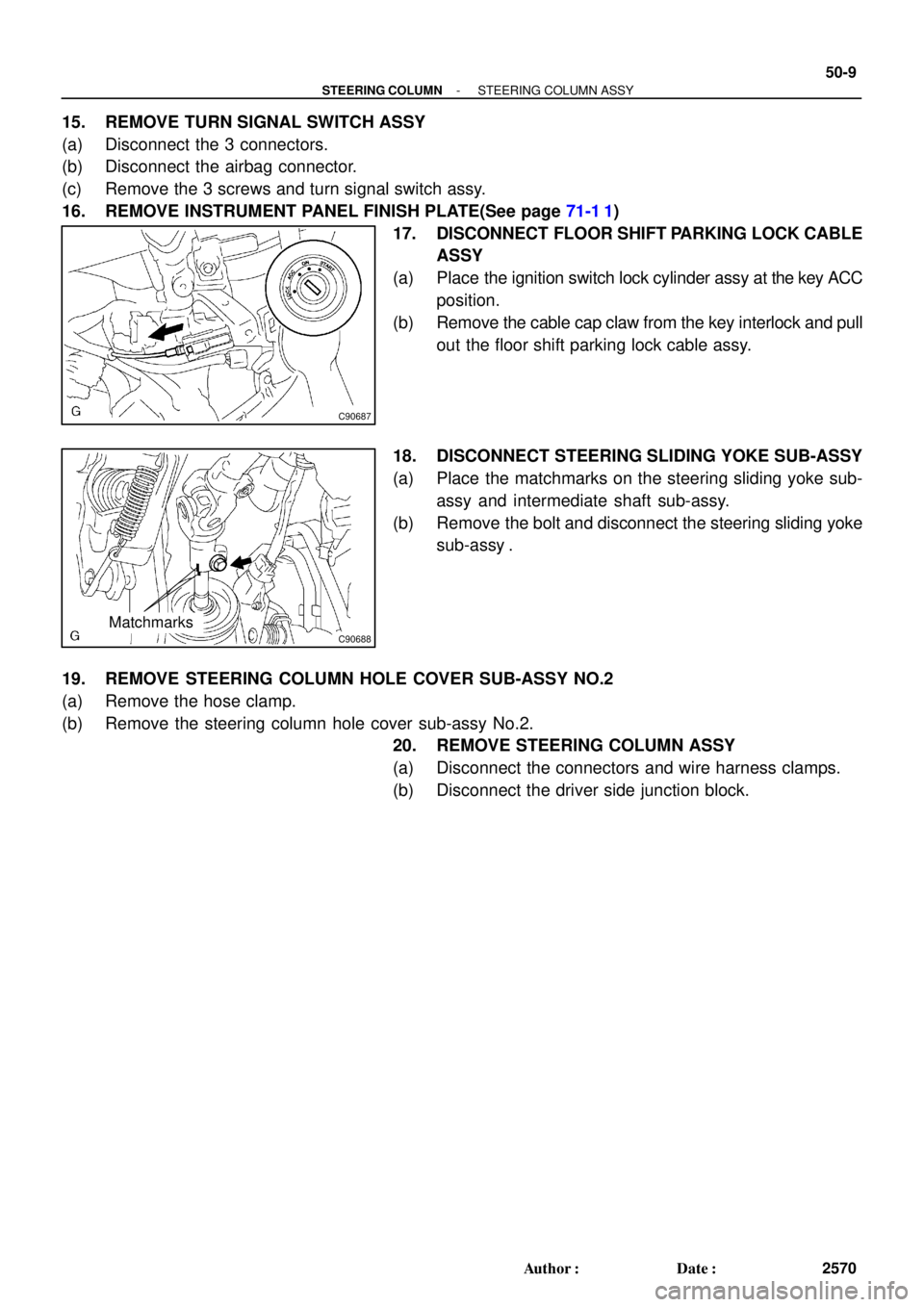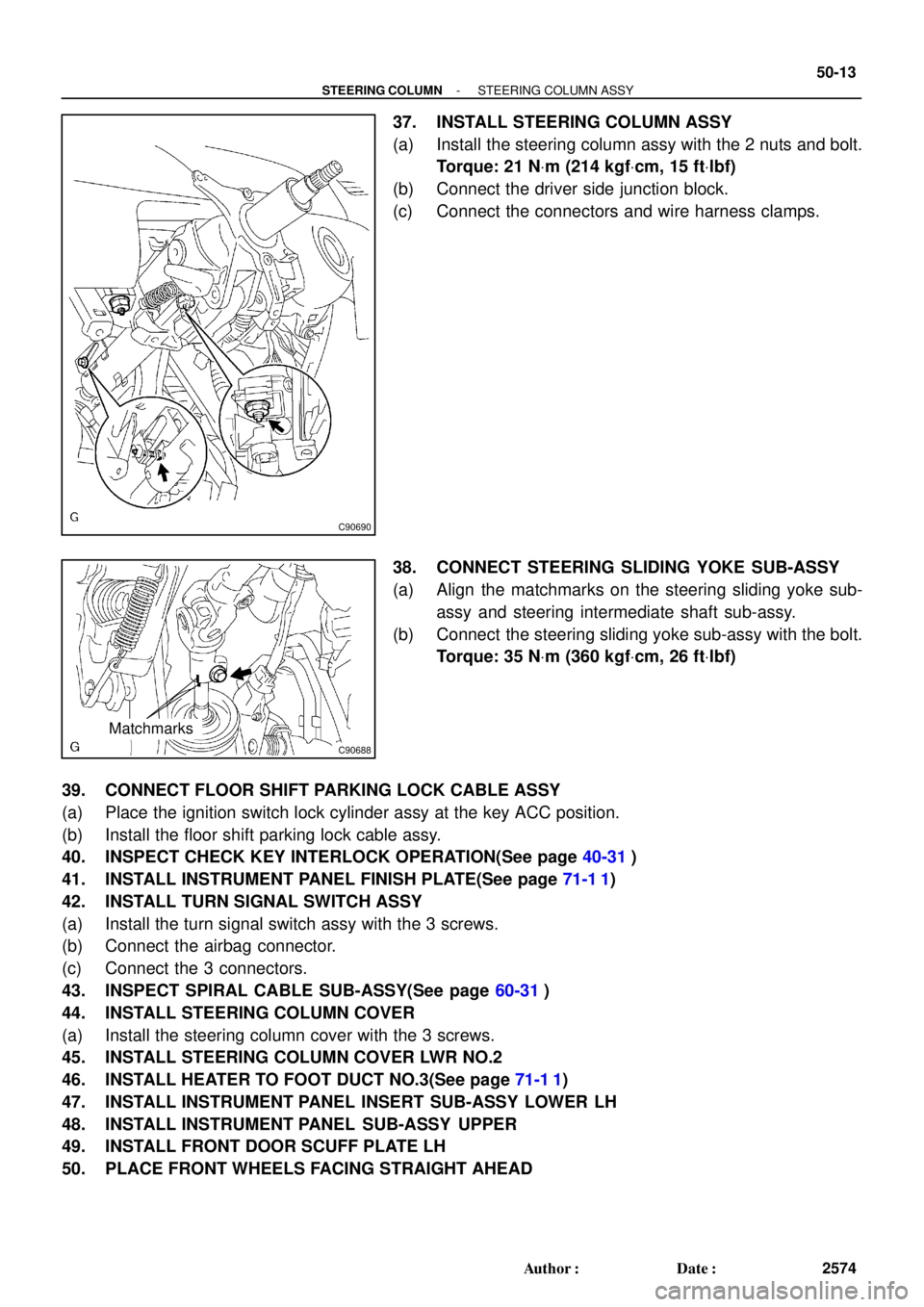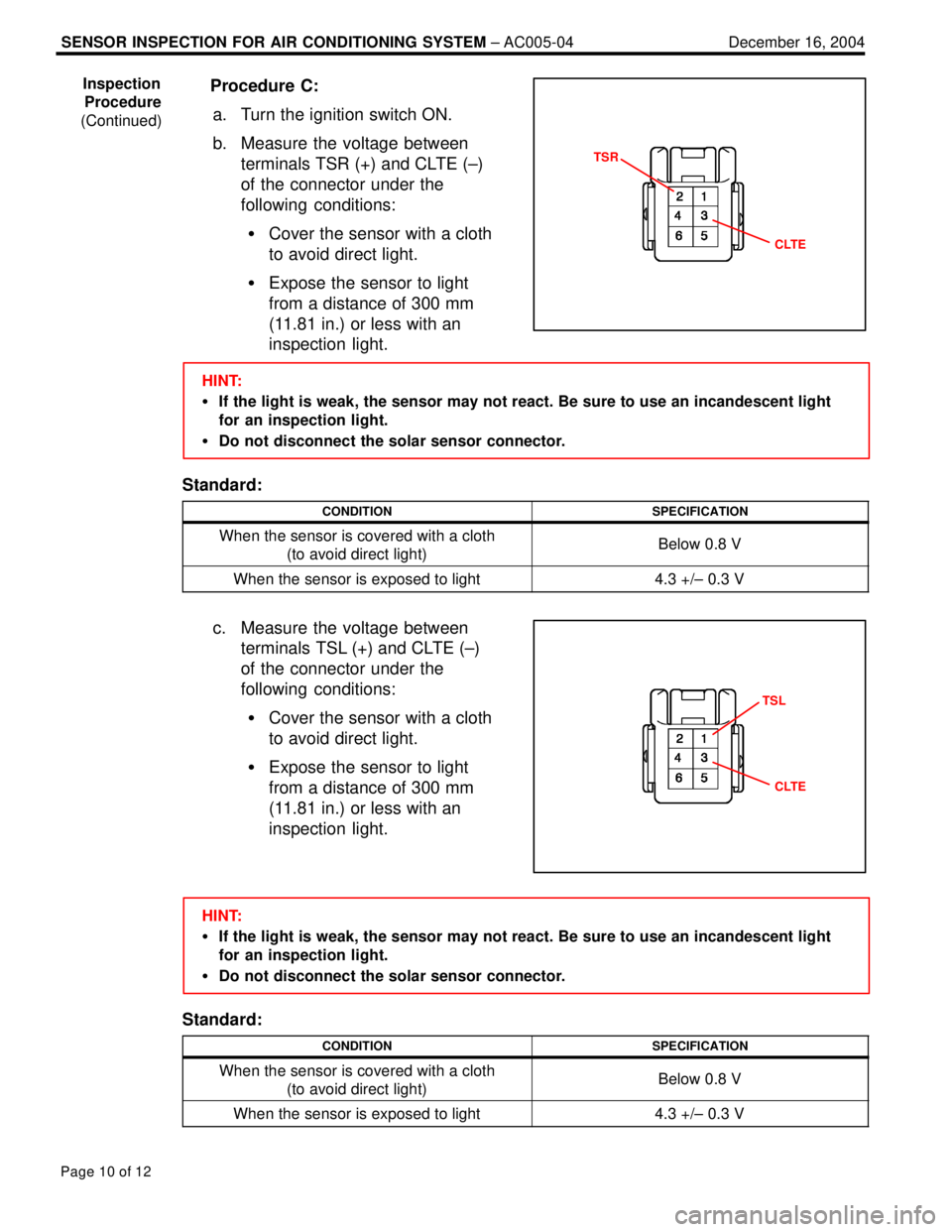Page 798 of 969

A01259
A01260
A82941
White Red Blue
B00543
- STARTING & CHARGINGCHARGING SYSTEM (3MZ-FE)
19-17
2349 Author�: Date�:
2005 LEXUS ES330 REPAIR MANUAL (RM1124U)
(b) Check the battery specific gravity.
(1) Check the specific gravity of each cell.
Standard specific gravity: 1.25 to 1.29 at 20�C (68�F)
If the specific gravity is less than specification, charge the bat-
tery.
(c) Check the battery voltage.
(1) If it has been less than 20 minutes since you
stopped driving the vehicle or since the engine was
stopped, turn the ignition switch and electrical sys-
tems (headlight, blower motor, rear defogger etc.)
to the ON position for 60 seconds. This will remove
the surface charge on the battery.
(2) Turn the ignition switch and electrical systems OFF.
(3) Using a voltmeter, measure the battery voltage be-
tween the negative (-) and positive (+) terminals of
the battery.
Standard voltage: 12.5 to 12.9 V at 20�C (68�F)
If the voltage is less than the specification, charge the battery.
(d) Check the indicator as shown in the illustration.
HINT:
�Blue: OK
�White: Charging Necessary
�Red: Insufficient Water
3. INSPECT BATTERY TERMINALS, FUSIBLE LINK AND FUSES
(a) Visually check the battery terminals.
(1) Check that the battery terminals are not loosened or corroded.
(b) Visually check the fusible link and fuses.
(1) Check that there is continuity of the fusible links, high current fuses and regular fuses.
4. INSPECT V-RIBBED BELT
(a) Visually check the belt for excessive wear, frayed cords,
etc.
�If any defects are found, replace the v-ribbed belt.
�Cracks on the rib side of the belt are considered ac-
ceptable.
If the belt has chunks missing from the ribs, it should
be replaced.
Page 799 of 969

B00540
A88419
Disconnect Wire
from Terminal B
Generator Voltmeter
BatteryAmmeter 19-18
- STARTING & CHARGINGCHARGING SYSTEM (3MZ-FE)
2350 Author�: Date�:
2005 LEXUS ES330 REPAIR MANUAL (RM1124U)
(b) Check that the belt fits properly in the ribbed grooves.
Confirm that the belt has not slipped out of the groove on the
bottom of the pulley by hand.
5. INSPECT GENERATOR WIRING
(a) Visually check the generator wiring.
(1) Check that the wiring is in good condition.
6. INSPECT ABNORMAL NOISES
(a) Listen to abnormal noises from generator.
(1) Check that no abnormal noise is heard from the generator while the engine is running.
7. INSPECT CHARGE WARNING LIGHT CIRCUIT
(a) Turn the ignition switch ON. Check that the charge warning light comes on.
(b) Start the engine, then check that the light goes off.
If the light does not operate as specified, troubleshoot the charge warning light circuit.
8. INSPECT CHARGING CIRCUIT WITHOUT LOAD
(a) If a tester is not available, connect a voltmeter to the
charging circuit as follows.
(1) Disconnect the wire from terminal B of the genera-
tor, then connect it to the negative (-) lead of the
ammeter.
(2) Connect the positive (+) lead of the ammeter to ter-
minal B of the generator.
(3) Connect the positive (+) lead of the voltmeter to ter-
minal B of the generator.
(4) Ground the negative (-) lead of the voltmeter.
(b) Check the charging circuit.
(1) Keep the engine speed at 2,000 rpm, then check
the reading on the ammeter and voltmeter.
Standard amperage: 10 A or less
Standard voltage: 13.2 to 14.8 V
9. INSPECT CHARGING CIRCUIT WITH LOAD
(a) With the engine running at 2,000 rpm, turn the high beam headlights ON and turn the heater blower
switch to the ºHIº position.
(b) Check the reading on the ammeter.
Standard amperage: 30 A or more
�If the ammeter reading is less than the standard amperage, repair the generator.
�If the battery is fully charged, the indication will sometimes be less than the standard amperage.
Page 816 of 969
C92308
NVm (kgfVcm, ftVlbf) : Specified torque
35 (360, 26)
��Non-reusable partUn-lock Waring
Switch AssyTransponder Key Amplifier
Ignition Switch Lock
Cylinder Assy
Steering Column Upper
w/ Switch Bracket Assy
Steering Column Assy
Ignition or Starter
Switch Assy
Steering Sliding
Yoke Sub-assySteering Column
Clamp Upper
� Tapered-Head Bolt
- STEERING COLUMNSTEERING COLUMN ASSY
50-7
2568 Author�: Date�:
2005 LEXUS ES330 REPAIR MANUAL (RM1124U)
Page 818 of 969

C90687
C90688Matchmarks
- STEERING COLUMNSTEERING COLUMN ASSY
50-9
2570 Author�: Date�:
15. REMOVE TURN SIGNAL SWITCH ASSY
(a) Disconnect the 3 connectors.
(b) Disconnect the airbag connector.
(c) Remove the 3 screws and turn signal switch assy.
16. REMOVE INSTRUMENT PANEL FINISH PLATE(See page 71-1 1)
17. DISCONNECT FLOOR SHIFT PARKING LOCK CABLE
ASSY
(a) Place the ignition switch lock cylinder assy at the key ACC
position.
(b) Remove the cable cap claw from the key interlock and pull
out the floor shift parking lock cable assy.
18. DISCONNECT STEERING SLIDING YOKE SUB-ASSY
(a) Place the matchmarks on the steering sliding yoke sub-
assy and intermediate shaft sub-assy.
(b) Remove the bolt and disconnect the steering sliding yoke
sub-assy .
19. REMOVE STEERING COLUMN HOLE COVER SUB-ASSY NO.2
(a) Remove the hose clamp.
(b) Remove the steering column hole cover sub-assy No.2.
20. REMOVE STEERING COLUMN ASSY
(a) Disconnect the connectors and wire harness clamps.
(b) Disconnect the driver side junction block.
Page 820 of 969

C90693
Screw Extractor
C90695
C90696
- STEERING COLUMNSTEERING COLUMN ASSY
50-1 1
2572 Author�: Date�:
24. REMOVE STEERING COLUMN UPPER W/SWITCH
BRACKET ASSY
(a) Using a centering punch, mark the center of the 2 ta-
pered-head bolts.
(b) Using a 3 - 4 mm (0.12 - 0.16 in.) drill, drill in to the 2 bolts.
(c) Using a screw extractor, remove the 2 bolts and steering
column upper w/switch bracket assy.
25. REMOVE IGNITION SWITCH LOCK CYLINDER ASSY
(a) Place the ignition switch lock cylinder assy at the ACC
position.
(b) Push down the stop pin with a screwdriver, and pull out
the ignition switch lock cylinder assy.
26. REMOVE UN-LOCK WARNING SWITCH ASSY
(a) Disconnect the un-lock warning switch assy connector
from the ignition or starter switch assy.
(b) Remove the un-lock warning switch assy by pushing up
the center part and releasing the 2 screws.
27. REMOVE IGNITION OR STARTER SWITCH ASSY
(a) Remove the 2 screws and ignition or starter switch assy from the steering column upper w/switch
bracket assy.
28. INSTALL IGNITION OR STARTER SWITCH ASSY
(a) Install the ignition switch assy to the steering column upper w/switch bracket assy with the 2 screws.
29. INSTALL UN-LOCK WARNING SWITCH ASSY
(a) Install the un-lock warning switch assy.
(b) Connect the un-lock warning switch assy connector to the ignition or starter switch assy.
30. INSTALL IGNITION SWITCH LOCK CYLINDER ASSY
(a) Make sure the ignition switch lock cylinder assy at the ACC position.
(b) Install the ignition switch lock cylinder assy.
31. INSPECT STEERING LOCK OPERATION
(a) Check that the steering lock mechanism is activated when removing the key.
(b) Check that the steering lock mechanism is deactivated when inserting the key and turning it to ACC
position.
Page 822 of 969

C90690
C90688
Matchmarks
- STEERING COLUMNSTEERING COLUMN ASSY
50-13
2574 Author�: Date�:
37. INSTALL STEERING COLUMN ASSY
(a) Install the steering column assy with the 2 nuts and bolt.
Torque: 21 NVm (214 kgfVcm, 15 ftVlbf)
(b) Connect the driver side junction block.
(c) Connect the connectors and wire harness clamps.
38. CONNECT STEERING SLIDING YOKE SUB-ASSY
(a) Align the matchmarks on the steering sliding yoke sub-
assy and steering intermediate shaft sub-assy.
(b) Connect the steering sliding yoke sub-assy with the bolt.
Torque: 35 NVm (360 kgfVcm, 26 ftVlbf)
39. CONNECT FLOOR SHIFT PARKING LOCK CABLE ASSY
(a) Place the ignition switch lock cylinder assy at the key ACC position.
(b) Install the floor shift parking lock cable assy.
40. INSPECT CHECK KEY INTERLOCK OPERATION(See page 40-31)
41. INSTALL INSTRUMENT PANEL FINISH PLATE(See page 71-1 1)
42. INSTALL TURN SIGNAL SWITCH ASSY
(a) Install the turn signal switch assy with the 3 screws.
(b) Connect the airbag connector.
(c) Connect the 3 connectors.
43. INSPECT SPIRAL CABLE SUB-ASSY(See page 60-31)
44. INSTALL STEERING COLUMN COVER
(a) Install the steering column cover with the 3 screws.
45. INSTALL STEERING COLUMN COVER LWR NO.2
46. INSTALL HEATER TO FOOT DUCT NO.3(See page 71-1 1)
47. INSTALL INSTRUMENT PANEL INSERT SUB-ASSY LOWER LH
48. INSTALL INSTRUMENT PANEL SUB-ASSY UPPER
49. INSTALL FRONT DOOR SCUFF PLATE LH
50. PLACE FRONT WHEELS FACING STRAIGHT AHEAD
Page 836 of 969

SENSOR INSPECTION FOR AIR CONDITIONING SYSTEM ± AC005-04 December 16, 2004
Page 10 of 12
Procedure C:
a. Turn the ignition switch ON.
b. Measure the voltage between
terminals TSR (+) and CLTE (±)
of the connector under the
following conditions:
�Cover the sensor with a cloth
to avoid direct light.
�Expose the sensor to light
from a distance of 300 mm
(11.81 in.) or less with an
inspection light.
HINT:
�If the light is weak, the sensor may not react. Be sure to use an incandescent light
for an inspection light.
�Do not disconnect the solar sensor connector.
Standard:
CONDITIONSPECIFICATION
When the sensor is covered with a cloth
(to avoid direct light)Below 0.8 V
When the sensor is exposed to light4.3 +/± 0.3 V
c. Measure the voltage between
terminals TSL (+) and CLTE (±)
of the connector under the
following conditions:
�Cover the sensor with a cloth
to avoid direct light.
�Expose the sensor to light
from a distance of 300 mm
(11.81 in.) or less with an
inspection light.
HINT:
�If the light is weak, the sensor may not react. Be sure to use an incandescent light
for an inspection light.
�Do not disconnect the solar sensor connector.
Standard:
CONDITIONSPECIFICATION
When the sensor is covered with a cloth
(to avoid direct light)Below 0.8 V
When the sensor is exposed to light4.3 +/± 0.3 V
Inspection
Procedure
(Continued)
CLTE TSR
TSL
CLTE
Page 837 of 969
SENSOR INSPECTION FOR AIR CONDITIONING SYSTEM ± AC005-04 December 16, 2004
Page 11 of 12
Procedure D:
a. Turn the ignition switch ON.
b. Using the tester, measure the
voltage between terminals
TSD (+) and CLTE (±) of the
connector under the
following conditions:
�Cover the sensor with a cloth
to avoid direct light.
�Expose the sensor to light
from a distance of 300 mm
(11.81 in.) or less with an
inspection light.
HINT:
�If the light is weak, the sensor may not react. Be sure to use an incandescent light
for an inspection light.
�Do not disconnect the solar sensor connector.
Standard:
CONDITIONSPECIFICATION
When the sensor is covered with a cloth
(to avoid direct light)Below 0.8 V
When the sensor is exposed to light4.3 +/± 0.3 V
Inspection
Procedure
(Continued)
TSD
CLTE